Types of aluminum pots, the nuances of their choice and operation

Every housewife in the kitchen probably has at least one aluminum saucepan. Dishes made of this material have gained popularity long ago and retains it to this day. Aluminum is a relatively inexpensive metal, therefore, products made from it are distinguished by an affordable price. However, excellent thermal conductivity is recognized as the main advantage of such cookware.
Advantages and disadvantages
As with any object, you can find both positives and flaws in an aluminum pan. The advantages of aluminum cookware include:
- relatively low cost;
- lightness of products;
- high thermal conductivity and, as a result, saving time for cooking;
- corrosion resistance;
- ease of care;
- durability.
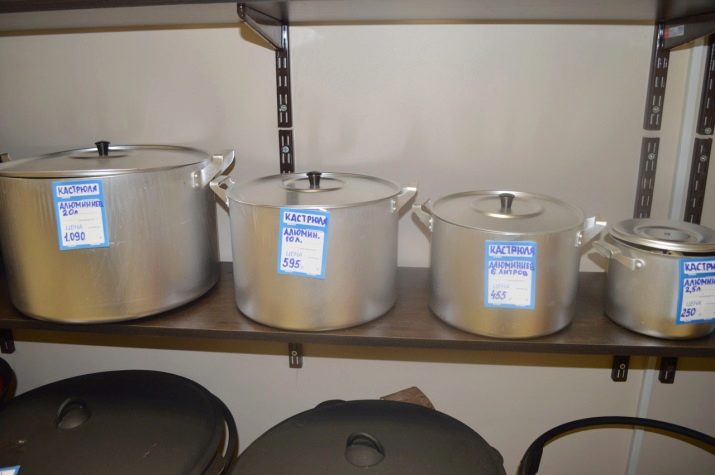
It is the low price of this type of tableware that makes it affordable.... But not all pots made of this metal are cheap. Those made of cast aluminum are expensive and very high quality cookware. Due to the lightness of the material, it is possible to produce large pots - 40, 50 and even 100 liters in volume. Such containers are popular in catering establishments.
Since aluminum perfectly conducts heat, the water in such dishes will boil much faster. With a shortage of time, this nuance is very important. Pots are not afraid of open flames and can be used to cook food on a gas burner or in an oven.
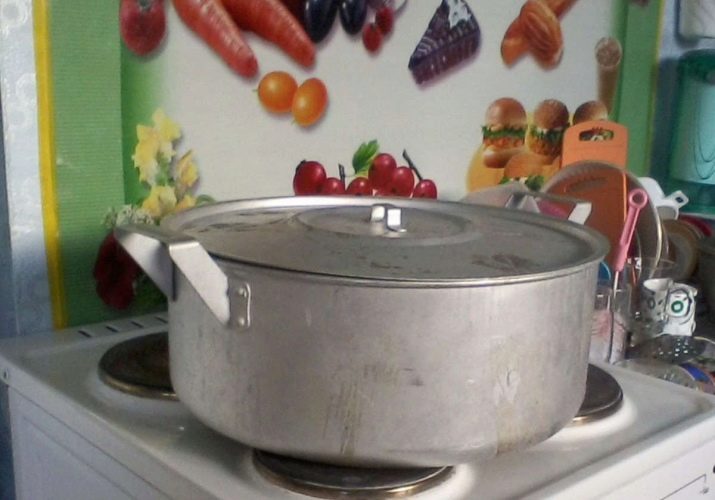
But in addition to the benefits, you need to take into account the disadvantages when using this type of tableware. Aluminum is a soft metal prone to deformation. For this reason, intensive and inaccurate cleaning of the product may leave scratches on it. And as a result of even a slight blow, a dent will appear.Over time, dark spots or streaks, scale from hard water can form on the dishes. Modern cleaning products help get rid of dirt without harming the pot.
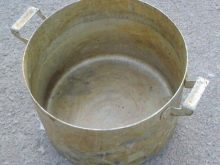


If the bottom of the cookware is thin and without a non-stick coating, the food is more likely to burn.... Products containing acid, when heat treated in an aluminum container, give a chemical reaction with the material, thereby having a harmful effect on the body.
Aluminum pots can be used for cooking, but it is better to store ready-made food in another container.
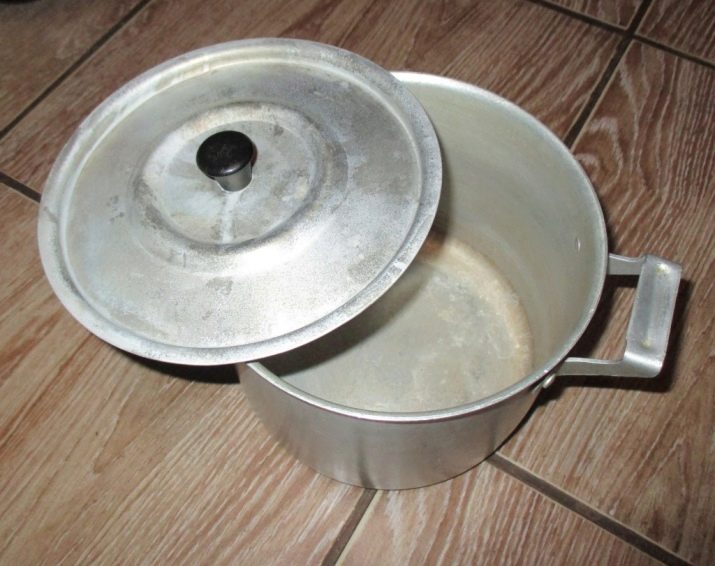
What are they?
Aluminum utensils are made in two ways: stamping (from sheet metal) and casting. The first method is less expensive, therefore it is considered a budget option, and therefore more in demand.
Stamping method
The essence of the manufacture of the product consists in stamping the product from the finished aluminum sheet. Then the blank is minted. This process involves a machine with a rotating blank. During minting, changes in the thickness of the metal downward are possible. Large pots are made in this way, but at the same time they are lightweight due to their thin walls.
Cookware manufacturers, trying to improve their own products, supplement them with a non-stick coating or attach an anti-deformation disc to the bottom. However, such additions are usually reflected in the price of the product.
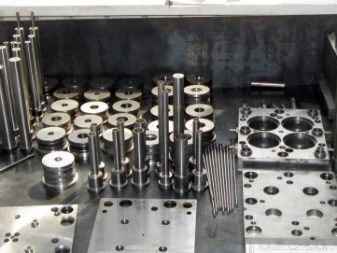
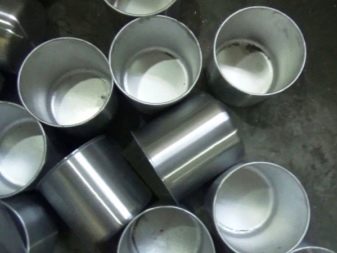
In addition to chasing, stamped aluminum cookware can be made using forging. This method is considered more costly, but the dishes made with it are much stronger. Forged aluminum resists deformation and has great thermal conductivity. The durability and practicality of such kitchen utensils will make the cooking process easy and enjoyable.
Casting method
Cookware made in this manner is similar to cast iron. It has a thick bottom and walls, this allows the contents of the pan to warm up evenly and keep it warm for a long time. The production technology consists in pouring molten aluminum into prepared molds. It is important to know that this method cannot be used to manufacture a product with a complex configuration. Cast pots come in only simple shapes, otherwise they simply cannot be removed from the workpiece.
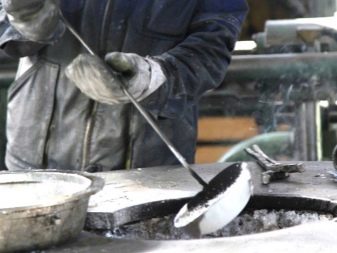
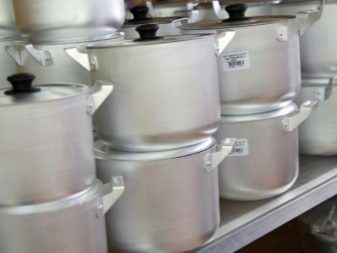
Currently, for ease of use and attractive appearance, manufacturers equip kitchen utensils with additional advantages, it could be:
- multilayer bottom;
- non-stick coating;
- external design.
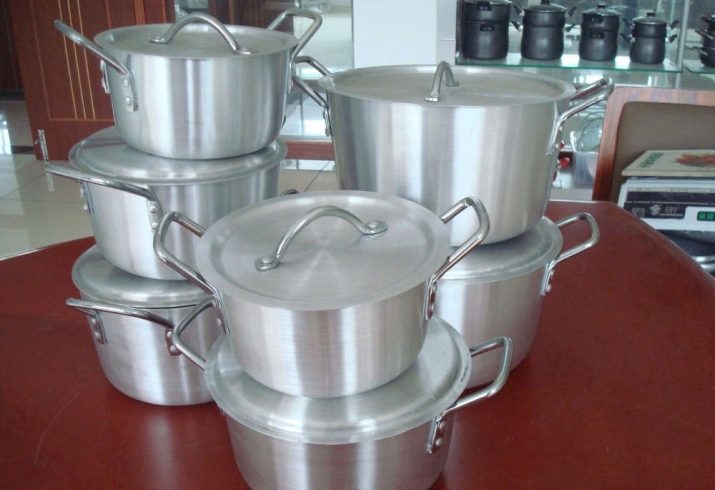
The base, consisting of several layers of metal, prevents warping and minimizes the heating time of the dishes. The product retains heat longer, and it is evenly distributed over the surface. For use on an induction hob, the manufacturer must indicate that there is a ferromagnetic alloy in the additional bottom layer, the base of which is copper.
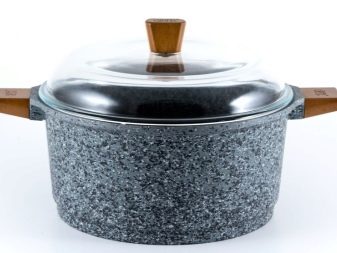

The non-stick coating provides additional assurance that food does not burn during cooking. Even if the pan is used exclusively for cooking, the additional inner coating will allow you to cook in it dishes that are undesirable to do in ordinary aluminum pans.

An additional layer to protect the product is applied in two ways: by rolling and spraying. In the first case, a sheet of aluminum is coated with a non-stick solution even before the pan is stamped. In the process of its manufacture, microcracks may appear, which will eventually make themselves felt.
The second method (spraying) is used to process finished products. Mostly forged or cast utensils are subjected to such finishing, since this process is energy-intensive and not cheap.
Aluminum pans are usually coated on the inside with the following coatings.
- Teflon. It must be treated very carefully so as not to damage it. In the process of cooking, it is recommended to use only silicone or wooden spoons, ladles, slotted spoon.
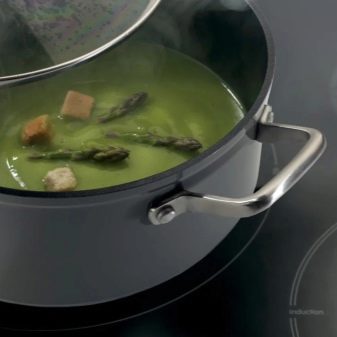
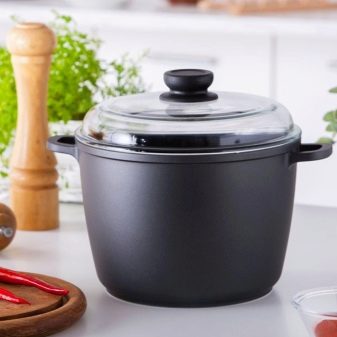
- Ceramic. May corrode with prolonged contact with liquids. Suitable for cooking with minimal water use.
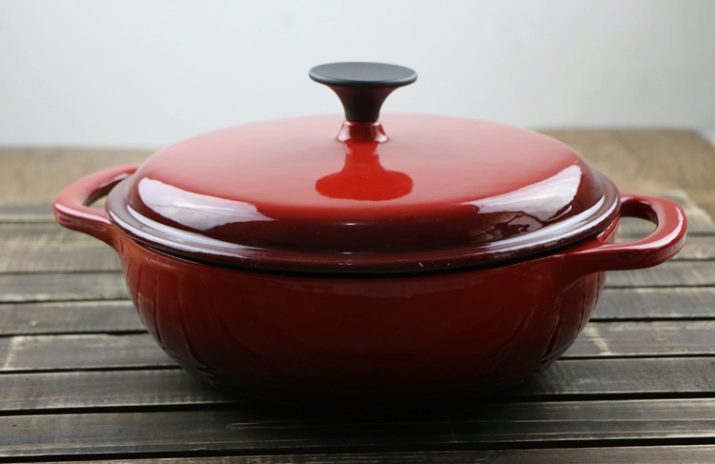
- Stone or titanium. The most practical and durable non-stick coating. It is not afraid of contact with metal and does not require special tools.
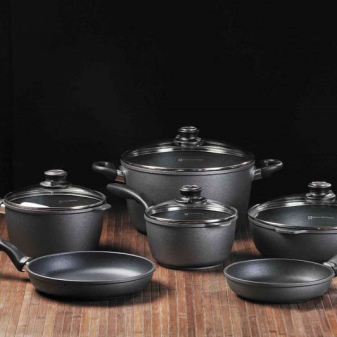
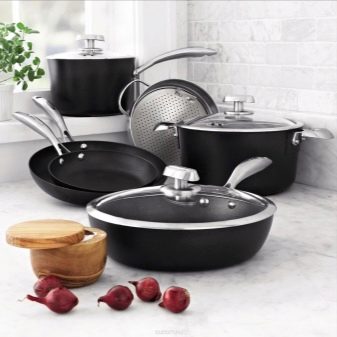
As for the external design, it all depends on the price of the product. The most budgetary copies are left without any coverage. But it should be noted that such a pan, having served for a very short time, loses its attractiveness. It may darken, stain, or stain. To prevent this from happening another layer is applied to the outside of the dishes, which acts as a decoration.
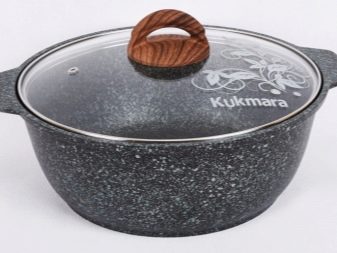
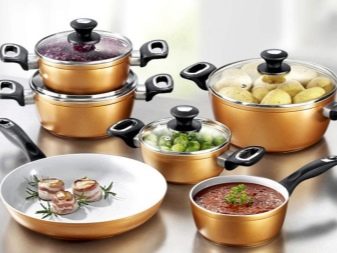
This is done in several ways: by applying colored varnish or enamel, anodizing and applying a porcelain solution with further firing of the product. It is worth remembering that dishes made of aluminum with internal and external finishing cannot be cheap.
Therefore, we must not forget for what purpose the kitchen utensils will be purchased and whether it is necessary to overpay.
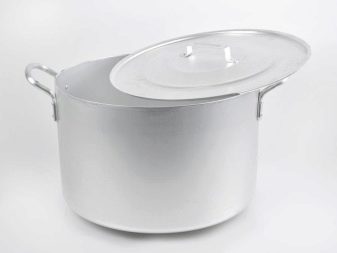
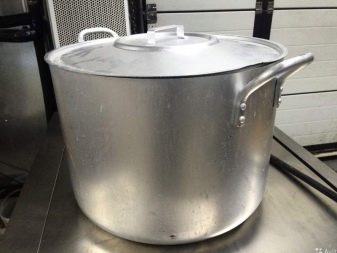
Criterias of choice
- To buy a suitable aluminum pan, you need to decide on its purpose. The volume of dishes is easy to calculate by comparing the number of family members with a standard portion. If it is, for example, pasta, then for cooking them you need a capacity of 3-5 liters, for porridge, a two-liter one will be enough. Eggs can be boiled even in 1 liter.
- The stove will help you choose the diameter of the pan, and, accordingly, the size of its bottom. When cooking on an electric stove, make sure that the size of the bottom matches the dimensions of the disc or spiral. With gas burners there will be no problems with any size of cookware. The same goes for glass-ceramic and induction hobs. If the hob allows you to cook in pots of any diameter, then for faster cooking it is better to choose a wide and low one.
- The purpose of the product will also help to determine the required thickness of the bottom and walls. For quick boiling and short-term use, thin-walled stampings are suitable. And for long-term heat treatment, cast or forged dishes are suitable.
- To be able to cook and store first courses, sauces or compotes in an aluminum pan, it must be non-stick. How exactly is a matter of taste and wallet.
- A lid is always included in a set with a saucepan, the only exception may be a saucepan. Usually, its thickness and structure correspond to the parameters of the product itself, and it adheres tightly to the surface. The lid can also be made of aluminum, and some models are produced with glass lids. It is desirable that there is a hole in it for steam to escape.
- Handles are an integral part of the pan. Cheap models are equipped with handles made of the same aluminum and are fixed with rivets or solder. In the process of cooking, they also heat up and you can only touch them with the help of oven mitts. For more expensive items, the handles are made of heat-resistant materials such as Bakelite or silicone.
- The handle on the lid is also important. It could be just an aluminum bracket, under which you can insert a plug for convenience. Most lids contain practical plastic handles.
- Before buying a saucepan, you need to carefully inspect the product. Check for dents and scratches. Make sure the handles are securely attached. If there is a non-stick or external coating, make sure that there are no cracks or chips.
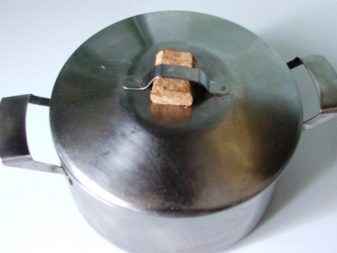
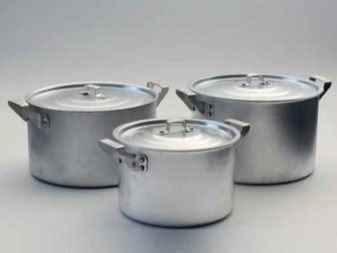
Care and use rules
Now on sale there is a huge amount of household chemicals for the kitchen and specifically for aluminum cookware. Some of them are not very effective, others are not entirely safe. Therefore, there are many popular ways to wash the pan from stubborn soot or scale. On some you can dwell in more detail.
- Blackness can be removed from the walls of the dishesby boiling the product in a solution of 10 liters of water, a glass of soda, a piece of laundry soap, grated, and 150 g of silicate glue. This should be done within 10 minutes. Rinse the dishes under running water and dry.
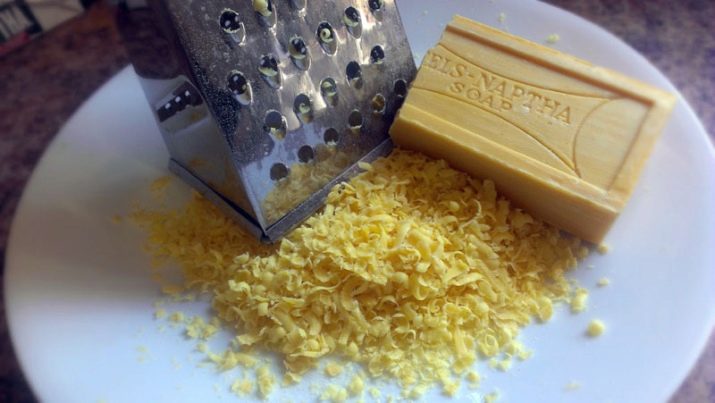
- You can also whiten the pan with 9% vinegar or citric acid.... They are also diluted with water and boiled for 15 minutes. You can remove blackness from the surface with soda. You will need to apply physical effort and a hard sponge.

- To remove scale will help ammonia - about 10 drops, together with 1/3 of a bar of laundry soap and 1 tablespoon of baking soda. Dilute all this in a little water. Pour the container with the solution, let stand for 1 hour, rinse well in running water. Vinegar also saves you from scale. It also needs to be dissolved in water and boiled for 15 minutes.

- If the aluminum pan turns dark after boiling water, you can bleach it by rubbing with a cut sour apple... Application of tooth powder to the wetted surface also helps. This is done overnight, then it is necessary to rinse well and dry the pan.
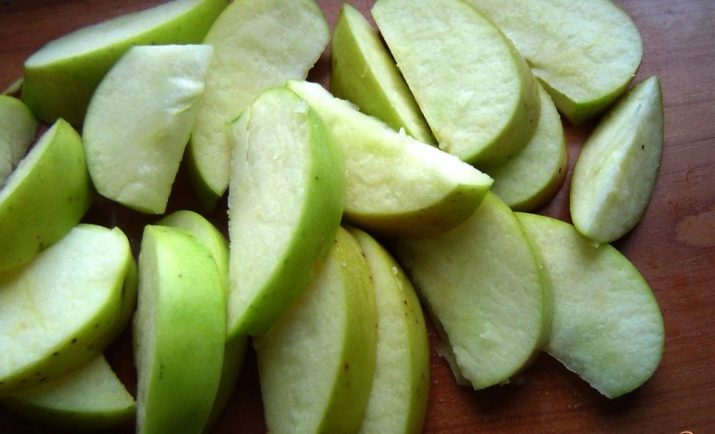
- Rubbing it with an ordinary school eraser helps to restore the original look to the pan. Even if it is black on the inside, this method will help remove all stains. Before using the dishes again for their intended purpose, they must be washed very well.
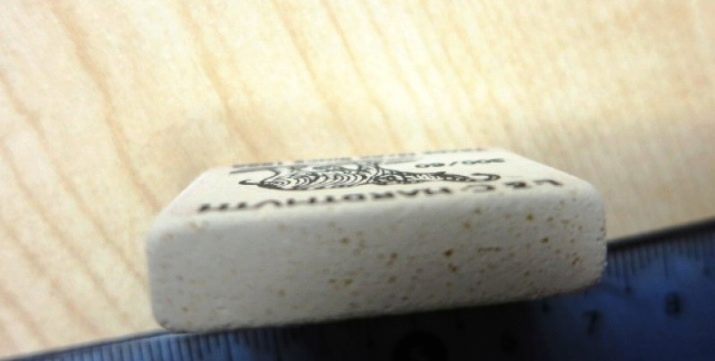
Aluminum cookware can be used in the process of cooking both on a gas or electric, and on a glass-ceramic stove. The main thing is that this possibility is indicated by the manufacturer, and the corresponding metal disc is present at the bottom.
You can put any aluminum cookware in the oven, except for the one with plastic handles. You can cook food in each of the models, but you can only store it in containers that have a non-stick coating. Salting lard or meat is also allowed, provided a special inner coating. Aluminum can react with salt and oxidize.
Boil porridge, pasta, dumplings, eggs, vegetables, meat - aluminum pots are suitable for this and much more.
For information on how to clean an aluminum pan from burning, see the next video.








